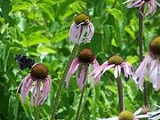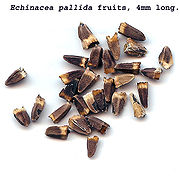
Echinacea pallida
Encyclopedia
Echinacea pallida commonly called Pale Purple Cone-flower, is a species of herbaceous
perennial plant in the family Asteraceae
. It is sometimes grown in gardens and used for medicinal purposes. Its native range is the south central region of the United States.
, but plants often grow taller, ranging from 1.5 to 2.5 ft (45 to 75 cm) tall, with some growing 3 feet (90 cm) or more tall. Plants normally grow with one unbranched stem
in the wild, but often produce multi-stemmed clumps in gardens. They have deep taproots that are spindle shaped, wider in the center and narrowing at the ends. Stems are green in color or mottled with purple and green. The leaves are elongated lanceolate or linear-lanceolate in shape with three veins. Flower head rays are narrow, linear, elongated, and drooping, ranging from 1 to 3 inches (2.5 to 7.6 cm) long. The flower heads are from ¾ to 3 inches (2 to 7.6 cm) wide with pale rose-purple or nearly white colored petals. The flowers have white pollen. The fruits are cypselae and are tan or bi-colored with angled edges.
and southward in to Alabama
and Texas
, and has been introduced outside of its native range into Connecticut, Georgia, Maine, Massachusetts, Minnesota, New York, North Carolina, and Virginia. E. pallida blooms from May into July. The states of Tennessee
and Wisconsin
list the species as threatened, mostly due to habitat loss and over-collection of roots, which are made into herbal medicine
. The use of Echinacea as a medicinal plant has not been demonstrated to have any positive health effects.


Herbaceous
A herbaceous plant is a plant that has leaves and stems that die down at the end of the growing season to the soil level. They have no persistent woody stem above ground...
perennial plant in the family Asteraceae
Asteraceae
The Asteraceae or Compositae , is an exceedingly large and widespread family of vascular plants. The group has more than 22,750 currently accepted species, spread across 1620 genera and 12 subfamilies...
. It is sometimes grown in gardens and used for medicinal purposes. Its native range is the south central region of the United States.
Description
E. pallida is similar to E. angustifoliaEchinacea angustifolia
Echinacea angustifolia is a herbaceous plant species in Asteraceae. The plants grow tall with spindle-shaped taproots that are often branched. The stems and leaves are moderately to densely hairy.E. angustifolia blooms late spring to mid summer...
, but plants often grow taller, ranging from 1.5 to 2.5 ft (45 to 75 cm) tall, with some growing 3 feet (90 cm) or more tall. Plants normally grow with one unbranched stem
Plant stem
A stem is one of two main structural axes of a vascular plant. The stem is normally divided into nodes and internodes, the nodes hold buds which grow into one or more leaves, inflorescence , conifer cones, roots, other stems etc. The internodes distance one node from another...
in the wild, but often produce multi-stemmed clumps in gardens. They have deep taproots that are spindle shaped, wider in the center and narrowing at the ends. Stems are green in color or mottled with purple and green. The leaves are elongated lanceolate or linear-lanceolate in shape with three veins. Flower head rays are narrow, linear, elongated, and drooping, ranging from 1 to 3 inches (2.5 to 7.6 cm) long. The flower heads are from ¾ to 3 inches (2 to 7.6 cm) wide with pale rose-purple or nearly white colored petals. The flowers have white pollen. The fruits are cypselae and are tan or bi-colored with angled edges.
Habitat and range
It is native to the United States where it is found growing in dry soils, in rocky prairies, open wooded hillsides, and glades. It grows natively as far north as MichiganMichigan
Michigan is a U.S. state located in the Great Lakes Region of the United States of America. The name Michigan is the French form of the Ojibwa word mishigamaa, meaning "large water" or "large lake"....
and southward in to Alabama
Alabama
Alabama is a state located in the southeastern region of the United States. It is bordered by Tennessee to the north, Georgia to the east, Florida and the Gulf of Mexico to the south, and Mississippi to the west. Alabama ranks 30th in total land area and ranks second in the size of its inland...
and Texas
Texas
Texas is the second largest U.S. state by both area and population, and the largest state by area in the contiguous United States.The name, based on the Caddo word "Tejas" meaning "friends" or "allies", was applied by the Spanish to the Caddo themselves and to the region of their settlement in...
, and has been introduced outside of its native range into Connecticut, Georgia, Maine, Massachusetts, Minnesota, New York, North Carolina, and Virginia. E. pallida blooms from May into July. The states of Tennessee
Tennessee
Tennessee is a U.S. state located in the Southeastern United States. It has a population of 6,346,105, making it the nation's 17th-largest state by population, and covers , making it the 36th-largest by total land area...
and Wisconsin
Wisconsin
Wisconsin is a U.S. state located in the north-central United States and is part of the Midwest. It is bordered by Minnesota to the west, Iowa to the southwest, Illinois to the south, Lake Michigan to the east, Michigan to the northeast, and Lake Superior to the north. Wisconsin's capital is...
list the species as threatened, mostly due to habitat loss and over-collection of roots, which are made into herbal medicine
Herbalism
Herbalism is a traditional medicinal or folk medicine practice based on the use of plants and plant extracts. Herbalism is also known as botanical medicine, medical herbalism, herbal medicine, herbology, herblore, and phytotherapy...
. The use of Echinacea as a medicinal plant has not been demonstrated to have any positive health effects.



